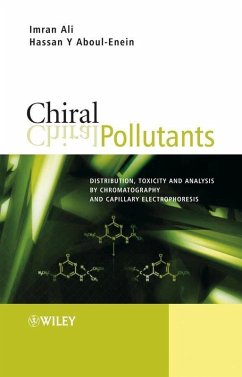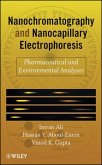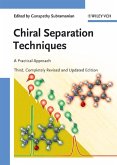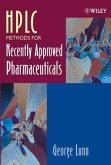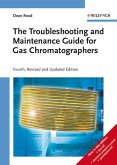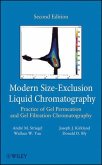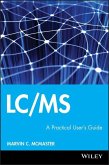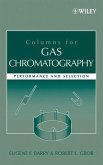Imran Ali, Hassan Y. Aboul-Enein
Chiral Pollutants (eBook, PDF)
Distribution, Toxicity and Analysis by Chromatography and Capillary Electrophoresis
228,99 €
228,99 €
inkl. MwSt.
Sofort per Download lieferbar

0 °P sammeln
228,99 €
Als Download kaufen

228,99 €
inkl. MwSt.
Sofort per Download lieferbar

0 °P sammeln
Jetzt verschenken
Alle Infos zum eBook verschenken
228,99 €
inkl. MwSt.
Sofort per Download lieferbar
Alle Infos zum eBook verschenken

0 °P sammeln
Imran Ali, Hassan Y. Aboul-Enein
Chiral Pollutants (eBook, PDF)
Distribution, Toxicity and Analysis by Chromatography and Capillary Electrophoresis
- Format: PDF
- Merkliste
- Auf die Merkliste
- Bewerten Bewerten
- Teilen
- Produkt teilen
- Produkterinnerung
- Produkterinnerung

Bitte loggen Sie sich zunächst in Ihr Kundenkonto ein oder registrieren Sie sich bei
bücher.de, um das eBook-Abo tolino select nutzen zu können.
Hier können Sie sich einloggen
Hier können Sie sich einloggen
Sie sind bereits eingeloggt. Klicken Sie auf 2. tolino select Abo, um fortzufahren.

Bitte loggen Sie sich zunächst in Ihr Kundenkonto ein oder registrieren Sie sich bei bücher.de, um das eBook-Abo tolino select nutzen zu können.
Today, among the various chiral discrimination methods, chromatography and capillary electrophoresis techniques have become powerful tools in environmental analysis. Therefore, there is a need to describe the art of the determination of the chiral pollutants in the environmental matrices. This book provides the complete information on the types of the chiral pollutants, their toxicities and methods of determination by chromatography and capillary electrophoresis.
- Geräte: PC
- mit Kopierschutz
- eBook Hilfe
- Größe: 2.79MB
Andere Kunden interessierten sich auch für
![Nanochromatography and Nanocapillary Electrophoresis (eBook, PDF) Nanochromatography and Nanocapillary Electrophoresis (eBook, PDF)]() Imran AliNanochromatography and Nanocapillary Electrophoresis (eBook, PDF)101,99 €
Imran AliNanochromatography and Nanocapillary Electrophoresis (eBook, PDF)101,99 €![Chiral Separation Techniques (eBook, PDF) Chiral Separation Techniques (eBook, PDF)]() Chiral Separation Techniques (eBook, PDF)252,99 €
Chiral Separation Techniques (eBook, PDF)252,99 €![HPLC Methods for Recently Approved Pharmaceuticals (eBook, PDF) HPLC Methods for Recently Approved Pharmaceuticals (eBook, PDF)]() George LunnHPLC Methods for Recently Approved Pharmaceuticals (eBook, PDF)217,99 €
George LunnHPLC Methods for Recently Approved Pharmaceuticals (eBook, PDF)217,99 €![The Troubleshooting and Maintenance Guide for Gas Chromatographers (eBook, PDF) The Troubleshooting and Maintenance Guide for Gas Chromatographers (eBook, PDF)]() Dean RoodThe Troubleshooting and Maintenance Guide for Gas Chromatographers (eBook, PDF)138,99 €
Dean RoodThe Troubleshooting and Maintenance Guide for Gas Chromatographers (eBook, PDF)138,99 €![Modern Size-Exclusion Liquid Chromatography (eBook, PDF) Modern Size-Exclusion Liquid Chromatography (eBook, PDF)]() Andre StriegelModern Size-Exclusion Liquid Chromatography (eBook, PDF)152,99 €
Andre StriegelModern Size-Exclusion Liquid Chromatography (eBook, PDF)152,99 €![LC/MS (eBook, PDF) LC/MS (eBook, PDF)]() Marvin McmasterLC/MS (eBook, PDF)90,99 €
Marvin McmasterLC/MS (eBook, PDF)90,99 €![Columns for Gas Chromatography (eBook, PDF) Columns for Gas Chromatography (eBook, PDF)]() Eugene F. BarryColumns for Gas Chromatography (eBook, PDF)136,99 €
Eugene F. BarryColumns for Gas Chromatography (eBook, PDF)136,99 €-
-
-
Today, among the various chiral discrimination methods, chromatography and capillary electrophoresis techniques have become powerful tools in environmental analysis. Therefore, there is a need to describe the art of the determination of the chiral pollutants in the environmental matrices. This book provides the complete information on the types of the chiral pollutants, their toxicities and methods of determination by chromatography and capillary electrophoresis.
Dieser Download kann aus rechtlichen Gründen nur mit Rechnungsadresse in A, B, BG, CY, CZ, D, DK, EW, E, FIN, F, GR, HR, H, IRL, I, LT, L, LR, M, NL, PL, P, R, S, SLO, SK ausgeliefert werden.
Produktdetails
- Produktdetails
- Verlag: John Wiley & Sons
- Seitenzahl: 368
- Erscheinungstermin: 15. Juli 2005
- Englisch
- ISBN-13: 9780470867815
- Artikelnr.: 37299621
- Verlag: John Wiley & Sons
- Seitenzahl: 368
- Erscheinungstermin: 15. Juli 2005
- Englisch
- ISBN-13: 9780470867815
- Artikelnr.: 37299621
- Herstellerkennzeichnung Die Herstellerinformationen sind derzeit nicht verfügbar.
Dr Imran Ali obtained his M.Sc. (1986) and Ph.D. (1990) degrees from the Indian Institute of Technology, Roorkee, India. At present, he is working as a Scientist in the National Institute of Hydrology, Roorkee, India. His research areas of interest are the chiral analysis of biologically and environmentally active chiral compounds, and metal ion speciation using chromatographic and capillary electrophoresis techniques. He also has expertise in water quality and wastewater treatment methodologies. Dr Ali is the author or co-author of more than 70 journal articles, book and encyclopedia chapters, and of a book entitled Chiral Separations by Liquid Chromatography and Related Technologies, published by Marcel Dekker, Inc., in New York. Dr Ali has been awarded a 'Khosla Research Award - 1987' by The Indian Institute of Technology, Roorkee, India, for work on the chiral resolution of amino acids. He is a life member of the Indian Science Congress Association. Professor Hassan Y. Aboul-Enein is a Principal Scientist and Head of the Pharmaceutical Analysis and Drug Development Laboratory at King Faisal Specialist Hospital and Research Centre, Riyadh, Saudi Arabia. He is the author or co-author of over 500 refereed journal articles, 30 book chapters and 270 conference presentations. He is the author of six books, including Chiral Separation by Liquid Chromatography and Related Technologies (Marcel Dekker, Inc.) and The Impact of Stereochemistry on Drug Development and Use (John Wiley&Sons, Ltd). He is amember of the Editorial Board of several journals, including Talanta, Chirality, Biomedical Chromatography, Analytical Letters, Talanta and Chromatographia. Professor Aboul-Enein is a member of the World Health Organization (WHO) advisory panel on international pharmacopeia and pharmaceutical preparations, and he is a Fellow of the Royal Society of Chemistry (UK). He received his B.Sc. degree (1964) in pharmacy and pharmaceutical chemistry from Cairo University, Cairo, Egypt, and his M.Sc. (1969) and Ph.D. (1971) degrees in pharmaceutical and medicinal chemistry from the University of Mississippi, Oxford, USA. Professor Aboul-Enein's current research interests are in the field of pharmaceutical and biomedical analysis and drug development, with a special emphasis on chiral chromatography, ion-selective electrodes and other separation techniques.
Preface.
Acknowledgements.
About the Book.
About the Authors.
1 Introduction.
1.1 The Importance of the Environment.
1.2 Environmental Pollutants.
1.3 Chirality and its Occurrence.
1.4 The Chemical Evolution of Chirality.
1.5 The Electronic Theory of Chirality.
1.6 The Importance of Chirality.
1.7 Nomenclature for Chiral Pollutants.
1.8 Chirality in Environmental Pollutants.
1.9 Chirality and its Consequences in the Environment.
1.10 The Enantiomeric Ratio and Fractions of Chiral Pollutants.
1.11 Methods for the Separation of Chiral Pollutants.
1.11.1 Chromatographic Methods.
1.11.2 The Capillary Electrophoretic Method.
1.12 Chiral Selectors in Chromatography and Capillary Electrophoresis.
1.13 Detection in Chromatography and Capillary Electrophoresis.
1.14 Other Methods of Separation of Chiral Pollutants.
References.
2 Chiral Pollutants: Sources and Distribution.
2.1 Introduction.
2.2 Sources of Contamination.
2.3 The Distribution of Chiral Pollutants.
2.3.1 Distribution in Water.
2.3.2 Distribution in Sediment.
2.3.3 Distribution in Soil.
2.3.4 Distribution in Air.
2.3.5 Distribution in Aquatic and Amphibian Biota.
2.3.6 Distribution in Terrestrial Biota.
2.3.7 Distribution in Food Products.
2.4 Conclusions.
References.
3 Chiral Pollutants: Biotransformation, Biodegradation and Metabolism.
3.1 Introduction.
3.2 The Mechanisms of the Interactions of Chiral Xenobiotics in Biological
Systems.
3.3 The Fate of Chiral Pollutants in the Ecosystem.
3.3.1 Biotransformation.
3.4 Photochemical Conversion.
3.5 Metabolism.
3.6 Conclusions.
References.
4 The Enantioselective Toxicities of Chiral Pollutants.
4.1 Introduction.
4.2 The Enantioselective Toxicities of PCBs.
4.3 The Enantioselective Toxicities of HCH.
4.4 The Enantioselective Toxicities of Other Chlorinated Pesticides.
4.5 The Enantioselective Toxicities of Phosphorous Pesticides.
4.6 The Enantioselective Toxicities of Polyaromatic Hydrocarbons (PAHs).
4.7 The Enantioselective Toxicities of Other Xenobiotics.
4.8 The Enantioselective Toxicities of Drugs and Pharmaceuticals.
4.9 Conclusions.
References.
5 Sample Preparation.
5.1 Introduction.
5.2 Sampling.
5.3 Filtration.
5.4 Homogenization.
5.5 Extraction.
5.5.1 The Extraction of Solid Samples.
5.5.2 The Extraction of Liquid Samples.
5.6 Membrane Methods in Sample Preparation.
5.7 Clean-up.
5.8 Pre-concentration.
5.9 Conclusions.
References.
6 The Analysis of Chiral Pollutants by Gas Chromatography.
6.1 Introduction.
6.2 Chiral Selectors.
6.2.1 Structures and Properties.
6.2.2 Preparation and Commercialization.
6.2.3 Other Chiral GC CSPs.
6.3 Applications.
6.4 The Optimization of GC Conditions.
6.4.1 Mobile Phases.
6.4.2 Temperature.
6.4.3 The Column Dimensions.
6.4.4 Structures and Types of Chiral Selectors.
6.4.5 The Structures of Chiral Pollutants.
6.4.6 Detection.
6.4.7 Other Parameters.
6.5 The Reverse Elution Order.
6.6 Errors and Problems in Enantioresolution.
6.7 The Derivatization of Chiral Environmental Pollutants.
6.8 Mechanisms of Chiral Resolution.
6.9 Conclusions.
References.
7 The Analysis of Chiral Pollutants by High Performance Liquid
Chromatography.
7.1 Introduction.
7.2 Chiral Selectors.
7.3 Applications.
7.4 The Optimization of HPLC Conditions.
7.4.1 Polysaccharide CSPs.
7.4.2 Cyclodextrin CSPs.
7.4.3 Macrocyclic Glycopeptide Antibiotic CSPs.
7.4.4 Protein CSPs.
7.4.5 Chiral Crown Ether CSPs.
7.4.6 Ligand Exchange CSPs.
7.4.7 Pirkle-type CSPs.
7.5 Detection.
7.6 Chiral Recognition Mechanisms.
7.7 Conclusions.
References.
8 The Analysis of Chiral Pollutants byMicellar Electrokinetic, Capillary
Electrochromatographic, Supercritical Fluid and Thin Layer Chromatographic
Techniques.
8.1 Introduction.
8.2 Chiral Selectors.
8.3 Micellar Electrokinetic Chromatography (MEKC).
8.4 Capillary Electrochromatography (CEC).
8.5 Supercritical Fluid Chromatography (SFC).
8.6 Thin Layer Chromatography (TLC).
8.7 LC versus GC.
8.8 Conclusions.
References.
9 The Analysis of Chiral Environmental Pollutants by Capillary
Electrophoresis.
9.1 Introduction.
9.2 Chiral Selectors.
9.3 Applications.
9.4 The Optimization of CE Conditions.
9.4.1 The Composition of the Background Electrolyte.
9.4.2 The pH of the Background Electrolyte.
9.4.3 The Ionic Strength of the Background Electrolyte.
9.4.4 Structures and Types of Chiral Selectors.
9.4.5 The Applied Voltage.
9.4.6 Temperature.
9.4.7 The Structures of Chiral Pollutants.
9.4.8 Organic Modifiers.
9.4.9 Other Parameters.
9.4.10 Optimization by Dependent Variables.
9.5 Detection.
9.6 Validation of Methods.
9.7 Mechanisms of Chiral Resolution.
9.8 CE versus HPLC.
9.9 Conclusions.
References.
10 Perspectives on the Analysis of Chiral Pollutants.
10.1 Introduction.
10.2 Regulations on Chirality in the USA.
10.3 Regulations on Chirality in Europe.
10.4 Regulations on Chirality in Japan.
10.5 Regulations on Chirality in Other Countries.
10.6 The Capabilities of Chiral Analysis Technologies.
10.7 The Large-scale Production of Pure Enantiomers.
10.8 The Impact of Chirality on Economic Growth.
10.9 Conclusions.
References.
Index.
Acknowledgements.
About the Book.
About the Authors.
1 Introduction.
1.1 The Importance of the Environment.
1.2 Environmental Pollutants.
1.3 Chirality and its Occurrence.
1.4 The Chemical Evolution of Chirality.
1.5 The Electronic Theory of Chirality.
1.6 The Importance of Chirality.
1.7 Nomenclature for Chiral Pollutants.
1.8 Chirality in Environmental Pollutants.
1.9 Chirality and its Consequences in the Environment.
1.10 The Enantiomeric Ratio and Fractions of Chiral Pollutants.
1.11 Methods for the Separation of Chiral Pollutants.
1.11.1 Chromatographic Methods.
1.11.2 The Capillary Electrophoretic Method.
1.12 Chiral Selectors in Chromatography and Capillary Electrophoresis.
1.13 Detection in Chromatography and Capillary Electrophoresis.
1.14 Other Methods of Separation of Chiral Pollutants.
References.
2 Chiral Pollutants: Sources and Distribution.
2.1 Introduction.
2.2 Sources of Contamination.
2.3 The Distribution of Chiral Pollutants.
2.3.1 Distribution in Water.
2.3.2 Distribution in Sediment.
2.3.3 Distribution in Soil.
2.3.4 Distribution in Air.
2.3.5 Distribution in Aquatic and Amphibian Biota.
2.3.6 Distribution in Terrestrial Biota.
2.3.7 Distribution in Food Products.
2.4 Conclusions.
References.
3 Chiral Pollutants: Biotransformation, Biodegradation and Metabolism.
3.1 Introduction.
3.2 The Mechanisms of the Interactions of Chiral Xenobiotics in Biological
Systems.
3.3 The Fate of Chiral Pollutants in the Ecosystem.
3.3.1 Biotransformation.
3.4 Photochemical Conversion.
3.5 Metabolism.
3.6 Conclusions.
References.
4 The Enantioselective Toxicities of Chiral Pollutants.
4.1 Introduction.
4.2 The Enantioselective Toxicities of PCBs.
4.3 The Enantioselective Toxicities of HCH.
4.4 The Enantioselective Toxicities of Other Chlorinated Pesticides.
4.5 The Enantioselective Toxicities of Phosphorous Pesticides.
4.6 The Enantioselective Toxicities of Polyaromatic Hydrocarbons (PAHs).
4.7 The Enantioselective Toxicities of Other Xenobiotics.
4.8 The Enantioselective Toxicities of Drugs and Pharmaceuticals.
4.9 Conclusions.
References.
5 Sample Preparation.
5.1 Introduction.
5.2 Sampling.
5.3 Filtration.
5.4 Homogenization.
5.5 Extraction.
5.5.1 The Extraction of Solid Samples.
5.5.2 The Extraction of Liquid Samples.
5.6 Membrane Methods in Sample Preparation.
5.7 Clean-up.
5.8 Pre-concentration.
5.9 Conclusions.
References.
6 The Analysis of Chiral Pollutants by Gas Chromatography.
6.1 Introduction.
6.2 Chiral Selectors.
6.2.1 Structures and Properties.
6.2.2 Preparation and Commercialization.
6.2.3 Other Chiral GC CSPs.
6.3 Applications.
6.4 The Optimization of GC Conditions.
6.4.1 Mobile Phases.
6.4.2 Temperature.
6.4.3 The Column Dimensions.
6.4.4 Structures and Types of Chiral Selectors.
6.4.5 The Structures of Chiral Pollutants.
6.4.6 Detection.
6.4.7 Other Parameters.
6.5 The Reverse Elution Order.
6.6 Errors and Problems in Enantioresolution.
6.7 The Derivatization of Chiral Environmental Pollutants.
6.8 Mechanisms of Chiral Resolution.
6.9 Conclusions.
References.
7 The Analysis of Chiral Pollutants by High Performance Liquid
Chromatography.
7.1 Introduction.
7.2 Chiral Selectors.
7.3 Applications.
7.4 The Optimization of HPLC Conditions.
7.4.1 Polysaccharide CSPs.
7.4.2 Cyclodextrin CSPs.
7.4.3 Macrocyclic Glycopeptide Antibiotic CSPs.
7.4.4 Protein CSPs.
7.4.5 Chiral Crown Ether CSPs.
7.4.6 Ligand Exchange CSPs.
7.4.7 Pirkle-type CSPs.
7.5 Detection.
7.6 Chiral Recognition Mechanisms.
7.7 Conclusions.
References.
8 The Analysis of Chiral Pollutants byMicellar Electrokinetic, Capillary
Electrochromatographic, Supercritical Fluid and Thin Layer Chromatographic
Techniques.
8.1 Introduction.
8.2 Chiral Selectors.
8.3 Micellar Electrokinetic Chromatography (MEKC).
8.4 Capillary Electrochromatography (CEC).
8.5 Supercritical Fluid Chromatography (SFC).
8.6 Thin Layer Chromatography (TLC).
8.7 LC versus GC.
8.8 Conclusions.
References.
9 The Analysis of Chiral Environmental Pollutants by Capillary
Electrophoresis.
9.1 Introduction.
9.2 Chiral Selectors.
9.3 Applications.
9.4 The Optimization of CE Conditions.
9.4.1 The Composition of the Background Electrolyte.
9.4.2 The pH of the Background Electrolyte.
9.4.3 The Ionic Strength of the Background Electrolyte.
9.4.4 Structures and Types of Chiral Selectors.
9.4.5 The Applied Voltage.
9.4.6 Temperature.
9.4.7 The Structures of Chiral Pollutants.
9.4.8 Organic Modifiers.
9.4.9 Other Parameters.
9.4.10 Optimization by Dependent Variables.
9.5 Detection.
9.6 Validation of Methods.
9.7 Mechanisms of Chiral Resolution.
9.8 CE versus HPLC.
9.9 Conclusions.
References.
10 Perspectives on the Analysis of Chiral Pollutants.
10.1 Introduction.
10.2 Regulations on Chirality in the USA.
10.3 Regulations on Chirality in Europe.
10.4 Regulations on Chirality in Japan.
10.5 Regulations on Chirality in Other Countries.
10.6 The Capabilities of Chiral Analysis Technologies.
10.7 The Large-scale Production of Pure Enantiomers.
10.8 The Impact of Chirality on Economic Growth.
10.9 Conclusions.
References.
Index.
Preface.
Acknowledgements.
About the Book.
About the Authors.
1 Introduction.
1.1 The Importance of the Environment.
1.2 Environmental Pollutants.
1.3 Chirality and its Occurrence.
1.4 The Chemical Evolution of Chirality.
1.5 The Electronic Theory of Chirality.
1.6 The Importance of Chirality.
1.7 Nomenclature for Chiral Pollutants.
1.8 Chirality in Environmental Pollutants.
1.9 Chirality and its Consequences in the Environment.
1.10 The Enantiomeric Ratio and Fractions of Chiral Pollutants.
1.11 Methods for the Separation of Chiral Pollutants.
1.11.1 Chromatographic Methods.
1.11.2 The Capillary Electrophoretic Method.
1.12 Chiral Selectors in Chromatography and Capillary Electrophoresis.
1.13 Detection in Chromatography and Capillary Electrophoresis.
1.14 Other Methods of Separation of Chiral Pollutants.
References.
2 Chiral Pollutants: Sources and Distribution.
2.1 Introduction.
2.2 Sources of Contamination.
2.3 The Distribution of Chiral Pollutants.
2.3.1 Distribution in Water.
2.3.2 Distribution in Sediment.
2.3.3 Distribution in Soil.
2.3.4 Distribution in Air.
2.3.5 Distribution in Aquatic and Amphibian Biota.
2.3.6 Distribution in Terrestrial Biota.
2.3.7 Distribution in Food Products.
2.4 Conclusions.
References.
3 Chiral Pollutants: Biotransformation, Biodegradation and Metabolism.
3.1 Introduction.
3.2 The Mechanisms of the Interactions of Chiral Xenobiotics in Biological
Systems.
3.3 The Fate of Chiral Pollutants in the Ecosystem.
3.3.1 Biotransformation.
3.4 Photochemical Conversion.
3.5 Metabolism.
3.6 Conclusions.
References.
4 The Enantioselective Toxicities of Chiral Pollutants.
4.1 Introduction.
4.2 The Enantioselective Toxicities of PCBs.
4.3 The Enantioselective Toxicities of HCH.
4.4 The Enantioselective Toxicities of Other Chlorinated Pesticides.
4.5 The Enantioselective Toxicities of Phosphorous Pesticides.
4.6 The Enantioselective Toxicities of Polyaromatic Hydrocarbons (PAHs).
4.7 The Enantioselective Toxicities of Other Xenobiotics.
4.8 The Enantioselective Toxicities of Drugs and Pharmaceuticals.
4.9 Conclusions.
References.
5 Sample Preparation.
5.1 Introduction.
5.2 Sampling.
5.3 Filtration.
5.4 Homogenization.
5.5 Extraction.
5.5.1 The Extraction of Solid Samples.
5.5.2 The Extraction of Liquid Samples.
5.6 Membrane Methods in Sample Preparation.
5.7 Clean-up.
5.8 Pre-concentration.
5.9 Conclusions.
References.
6 The Analysis of Chiral Pollutants by Gas Chromatography.
6.1 Introduction.
6.2 Chiral Selectors.
6.2.1 Structures and Properties.
6.2.2 Preparation and Commercialization.
6.2.3 Other Chiral GC CSPs.
6.3 Applications.
6.4 The Optimization of GC Conditions.
6.4.1 Mobile Phases.
6.4.2 Temperature.
6.4.3 The Column Dimensions.
6.4.4 Structures and Types of Chiral Selectors.
6.4.5 The Structures of Chiral Pollutants.
6.4.6 Detection.
6.4.7 Other Parameters.
6.5 The Reverse Elution Order.
6.6 Errors and Problems in Enantioresolution.
6.7 The Derivatization of Chiral Environmental Pollutants.
6.8 Mechanisms of Chiral Resolution.
6.9 Conclusions.
References.
7 The Analysis of Chiral Pollutants by High Performance Liquid
Chromatography.
7.1 Introduction.
7.2 Chiral Selectors.
7.3 Applications.
7.4 The Optimization of HPLC Conditions.
7.4.1 Polysaccharide CSPs.
7.4.2 Cyclodextrin CSPs.
7.4.3 Macrocyclic Glycopeptide Antibiotic CSPs.
7.4.4 Protein CSPs.
7.4.5 Chiral Crown Ether CSPs.
7.4.6 Ligand Exchange CSPs.
7.4.7 Pirkle-type CSPs.
7.5 Detection.
7.6 Chiral Recognition Mechanisms.
7.7 Conclusions.
References.
8 The Analysis of Chiral Pollutants byMicellar Electrokinetic, Capillary
Electrochromatographic, Supercritical Fluid and Thin Layer Chromatographic
Techniques.
8.1 Introduction.
8.2 Chiral Selectors.
8.3 Micellar Electrokinetic Chromatography (MEKC).
8.4 Capillary Electrochromatography (CEC).
8.5 Supercritical Fluid Chromatography (SFC).
8.6 Thin Layer Chromatography (TLC).
8.7 LC versus GC.
8.8 Conclusions.
References.
9 The Analysis of Chiral Environmental Pollutants by Capillary
Electrophoresis.
9.1 Introduction.
9.2 Chiral Selectors.
9.3 Applications.
9.4 The Optimization of CE Conditions.
9.4.1 The Composition of the Background Electrolyte.
9.4.2 The pH of the Background Electrolyte.
9.4.3 The Ionic Strength of the Background Electrolyte.
9.4.4 Structures and Types of Chiral Selectors.
9.4.5 The Applied Voltage.
9.4.6 Temperature.
9.4.7 The Structures of Chiral Pollutants.
9.4.8 Organic Modifiers.
9.4.9 Other Parameters.
9.4.10 Optimization by Dependent Variables.
9.5 Detection.
9.6 Validation of Methods.
9.7 Mechanisms of Chiral Resolution.
9.8 CE versus HPLC.
9.9 Conclusions.
References.
10 Perspectives on the Analysis of Chiral Pollutants.
10.1 Introduction.
10.2 Regulations on Chirality in the USA.
10.3 Regulations on Chirality in Europe.
10.4 Regulations on Chirality in Japan.
10.5 Regulations on Chirality in Other Countries.
10.6 The Capabilities of Chiral Analysis Technologies.
10.7 The Large-scale Production of Pure Enantiomers.
10.8 The Impact of Chirality on Economic Growth.
10.9 Conclusions.
References.
Index.
Acknowledgements.
About the Book.
About the Authors.
1 Introduction.
1.1 The Importance of the Environment.
1.2 Environmental Pollutants.
1.3 Chirality and its Occurrence.
1.4 The Chemical Evolution of Chirality.
1.5 The Electronic Theory of Chirality.
1.6 The Importance of Chirality.
1.7 Nomenclature for Chiral Pollutants.
1.8 Chirality in Environmental Pollutants.
1.9 Chirality and its Consequences in the Environment.
1.10 The Enantiomeric Ratio and Fractions of Chiral Pollutants.
1.11 Methods for the Separation of Chiral Pollutants.
1.11.1 Chromatographic Methods.
1.11.2 The Capillary Electrophoretic Method.
1.12 Chiral Selectors in Chromatography and Capillary Electrophoresis.
1.13 Detection in Chromatography and Capillary Electrophoresis.
1.14 Other Methods of Separation of Chiral Pollutants.
References.
2 Chiral Pollutants: Sources and Distribution.
2.1 Introduction.
2.2 Sources of Contamination.
2.3 The Distribution of Chiral Pollutants.
2.3.1 Distribution in Water.
2.3.2 Distribution in Sediment.
2.3.3 Distribution in Soil.
2.3.4 Distribution in Air.
2.3.5 Distribution in Aquatic and Amphibian Biota.
2.3.6 Distribution in Terrestrial Biota.
2.3.7 Distribution in Food Products.
2.4 Conclusions.
References.
3 Chiral Pollutants: Biotransformation, Biodegradation and Metabolism.
3.1 Introduction.
3.2 The Mechanisms of the Interactions of Chiral Xenobiotics in Biological
Systems.
3.3 The Fate of Chiral Pollutants in the Ecosystem.
3.3.1 Biotransformation.
3.4 Photochemical Conversion.
3.5 Metabolism.
3.6 Conclusions.
References.
4 The Enantioselective Toxicities of Chiral Pollutants.
4.1 Introduction.
4.2 The Enantioselective Toxicities of PCBs.
4.3 The Enantioselective Toxicities of HCH.
4.4 The Enantioselective Toxicities of Other Chlorinated Pesticides.
4.5 The Enantioselective Toxicities of Phosphorous Pesticides.
4.6 The Enantioselective Toxicities of Polyaromatic Hydrocarbons (PAHs).
4.7 The Enantioselective Toxicities of Other Xenobiotics.
4.8 The Enantioselective Toxicities of Drugs and Pharmaceuticals.
4.9 Conclusions.
References.
5 Sample Preparation.
5.1 Introduction.
5.2 Sampling.
5.3 Filtration.
5.4 Homogenization.
5.5 Extraction.
5.5.1 The Extraction of Solid Samples.
5.5.2 The Extraction of Liquid Samples.
5.6 Membrane Methods in Sample Preparation.
5.7 Clean-up.
5.8 Pre-concentration.
5.9 Conclusions.
References.
6 The Analysis of Chiral Pollutants by Gas Chromatography.
6.1 Introduction.
6.2 Chiral Selectors.
6.2.1 Structures and Properties.
6.2.2 Preparation and Commercialization.
6.2.3 Other Chiral GC CSPs.
6.3 Applications.
6.4 The Optimization of GC Conditions.
6.4.1 Mobile Phases.
6.4.2 Temperature.
6.4.3 The Column Dimensions.
6.4.4 Structures and Types of Chiral Selectors.
6.4.5 The Structures of Chiral Pollutants.
6.4.6 Detection.
6.4.7 Other Parameters.
6.5 The Reverse Elution Order.
6.6 Errors and Problems in Enantioresolution.
6.7 The Derivatization of Chiral Environmental Pollutants.
6.8 Mechanisms of Chiral Resolution.
6.9 Conclusions.
References.
7 The Analysis of Chiral Pollutants by High Performance Liquid
Chromatography.
7.1 Introduction.
7.2 Chiral Selectors.
7.3 Applications.
7.4 The Optimization of HPLC Conditions.
7.4.1 Polysaccharide CSPs.
7.4.2 Cyclodextrin CSPs.
7.4.3 Macrocyclic Glycopeptide Antibiotic CSPs.
7.4.4 Protein CSPs.
7.4.5 Chiral Crown Ether CSPs.
7.4.6 Ligand Exchange CSPs.
7.4.7 Pirkle-type CSPs.
7.5 Detection.
7.6 Chiral Recognition Mechanisms.
7.7 Conclusions.
References.
8 The Analysis of Chiral Pollutants byMicellar Electrokinetic, Capillary
Electrochromatographic, Supercritical Fluid and Thin Layer Chromatographic
Techniques.
8.1 Introduction.
8.2 Chiral Selectors.
8.3 Micellar Electrokinetic Chromatography (MEKC).
8.4 Capillary Electrochromatography (CEC).
8.5 Supercritical Fluid Chromatography (SFC).
8.6 Thin Layer Chromatography (TLC).
8.7 LC versus GC.
8.8 Conclusions.
References.
9 The Analysis of Chiral Environmental Pollutants by Capillary
Electrophoresis.
9.1 Introduction.
9.2 Chiral Selectors.
9.3 Applications.
9.4 The Optimization of CE Conditions.
9.4.1 The Composition of the Background Electrolyte.
9.4.2 The pH of the Background Electrolyte.
9.4.3 The Ionic Strength of the Background Electrolyte.
9.4.4 Structures and Types of Chiral Selectors.
9.4.5 The Applied Voltage.
9.4.6 Temperature.
9.4.7 The Structures of Chiral Pollutants.
9.4.8 Organic Modifiers.
9.4.9 Other Parameters.
9.4.10 Optimization by Dependent Variables.
9.5 Detection.
9.6 Validation of Methods.
9.7 Mechanisms of Chiral Resolution.
9.8 CE versus HPLC.
9.9 Conclusions.
References.
10 Perspectives on the Analysis of Chiral Pollutants.
10.1 Introduction.
10.2 Regulations on Chirality in the USA.
10.3 Regulations on Chirality in Europe.
10.4 Regulations on Chirality in Japan.
10.5 Regulations on Chirality in Other Countries.
10.6 The Capabilities of Chiral Analysis Technologies.
10.7 The Large-scale Production of Pure Enantiomers.
10.8 The Impact of Chirality on Economic Growth.
10.9 Conclusions.
References.
Index.
